#mental health resources
Text

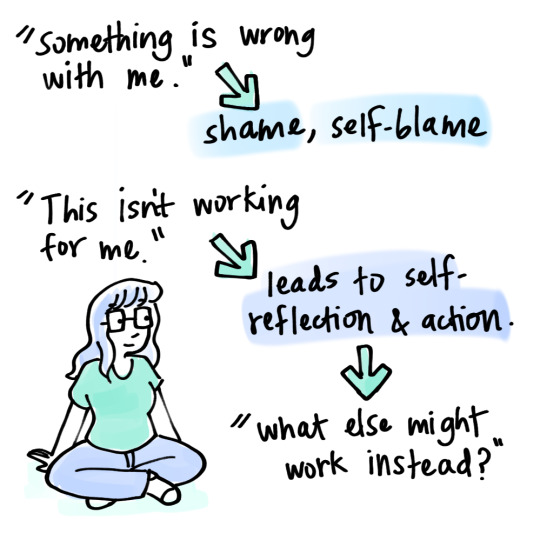
11K notes
·
View notes
Text
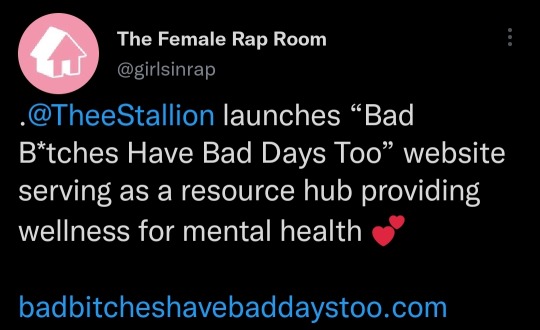

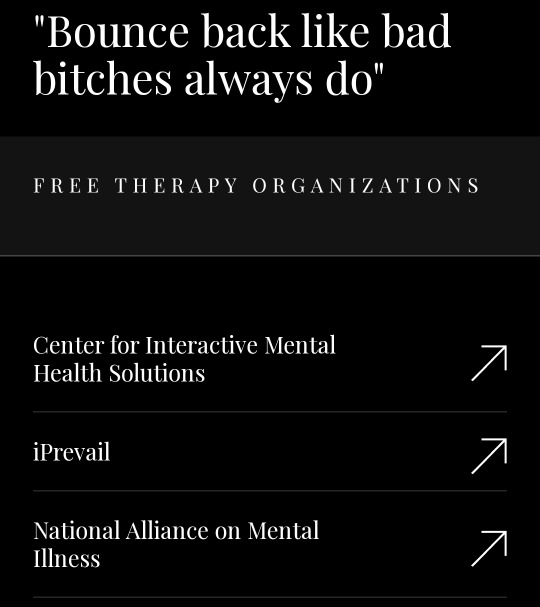
43K notes
·
View notes
Text
…this is actually a bunch of friendly but important reminders standing on each others’ shoulders in a poll-shaped trench coat. btw
#poll blog#random polls#silly polls#stupid polls#polls#silly poll#tumblr polls#poll#mental health#self care#self love#wholesome content#take care of yourself#chronic illness#self improvement#chronic fatigue#disability#mental illness#mental health resources#mental health tips#friendly reminder#love yourself#mental health matters#self healing#self empowerment#self worth#drink water#stay hydrated#take a nap#stress management
131 notes
·
View notes
Text
⚠️ emergency links
this is a list of resources for when you're in crisis, whether you're suicidal, triggered, having a panic attack, or any other mental health emergency.
this list will be updated with new resources as i find them.
emergency numbers for your country
helplines for your country
Australia: lifeline 13 11 14 & other helplines
managing flashbacks
quick helpful tips for suicidal feelings
you feel like shit interactive self care guide (alternative site)
reassurance masterpost
Get Self Help
psychosis coping strategies
grounding techniques
dealing with trauma triggers & OCD
DBT options for solving problems
self-soothing ideas
how to check the (emotional) facts
TIPP grounding skill (temperature, intense exercise, paced breathing, progressive muscle relaxation)
ideas for soothing impulses (urge surfing)
tips for when it feels too much
why am i feeling bad? flowchart
looking after yourself (particularly tolerating distress)
staying safe in a crisis
crisis support (particularly for dissociation & dissociative identity disorder)
safety tools & resources
dealing with PTSD triggers
grounding & containment strategies
#resources#mental health resources#emergency resources#crisis resources#crisis#emergency#grounding#trauma#suicidal ideation#suicide#dogpost#sos#help#self help#self soothing#self care
57 notes
·
View notes
Text
Knowing and admitting you need help is one thing
but knowing what help you need or how to acquire it or where to even start is a whole other thing entirely.
Anyone have any tips or resources for this?
#audhd#cptsd recovery#borderline personality disorder#late diagnosed autistic#actually autistic#neurodiversity#disability resources#mental health resources#adhd resources#bpd help#did osdd#chronic illness#chronic pain#mental health help#mental illness#accessibility#intersectionality#healthcare#mental health education#executive dysfunction#self care#mental health community#autistic community#late diagnosis#unmedicated#living with adhd#adhd autistic#adhd help#adhd problems#adhd community
139 notes
·
View notes
Text
Emotional Regulation- what's it all about?

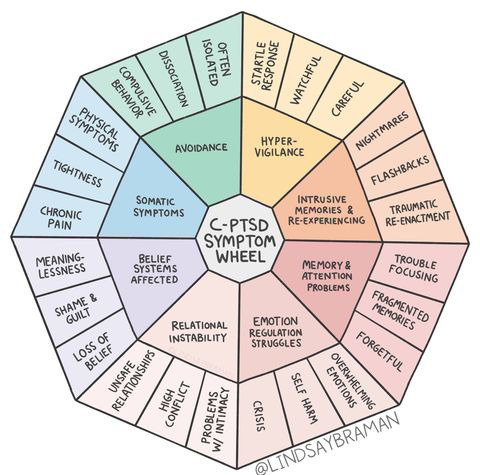
Emotional regulation is the work of releasing pent up stress from your nervous system.
Your body has an entire system of automatic stress responses. Some of which can be born out of hard wired prolonged exposure to trauma in our childhoods.
With no proper regulation from our abusive & neglectful parents, many of us are still stuck in these same fear responses from our childhoods. Which means a lot of that fear, sadness, guilt, and shame, reappears in the form of how we cope now as an adult.
By learning how to recognize which state of survival you're in- and you can be in all states at different times and triggers- you can then work on giving your body a more directed route to releasing the pent up exhaustion, fear, tension, and panic.
Which in turn gives us more room to breathe easier when we are feeling stress, panicked, and triggered.
There are many techniques to help with emotional regulation. Somatics is the practice of moving your body to release the energy.
This is why everyone will scream yoga and exercise at you. But its not just limited to those two types of movements.
If you are bed bound, somatics can be as simple as raising your arms, lifting your legs, and rolling your neck.
The key idea is to recognize when you're overwhelmed, panicked, and triggered in your day to day life. Work real hard on bringing these moments into your awareness. What are your thoughts like? What are your reactions?
From there we work to integrate a basic somatic framework over time. This can look like working hard to incorporate some form of comfort, movement, and acceptance for the physical discomforts of these moments.
A basic framework can include:
Butterfly hugs (put ur hand over ur heart)
Self hugs
Hold your shoulders
Rub your shoulders, arms, tummy, and legs
Lift ur shoulders, shake ur arms, clench ur fists
Wiggle in ur seat
Raise ur legs, stomp your feet gently in place, roll ur ankles
Deep breathing
Groaning, sighing, screaming, making noise
Humming or singing
Outwardly showing emotions on your face
Cold/warm compress or towel
Weighted blankets or comfort items
Sensory stems
These are just a few examples. You can literally do whatever types of movements that feel natural for you.
The secondary idea of emotional regulation is self expression.
That's why it's okay to groan and scream and be loud and expressive in these moments, if you need to. Remember that most often panic attacks, stress, anxiety, and triggers are deeply emotional responses to very personal scenarios and traumas that we have endured in our past. Some of these fears stem from some really scary places. It makes a lot of sense that you might need to scream, cower in fear, or use facial expressions in these moments.
Oftentimes in abusive environments we are restrained from doing so by our abusers. When in reality, these are the standard reactions for what we went through. These are the types of reactions that our bodies are repressing.
It can feel overwhelming to think about acting in such ways, especially if you're not able to practice these in peace, solitude, and safety. But please know that how you cope is an extremely personal and extremely precious part of who you are. Do whatever you need to do for your health and safety and stability and peace of mind. That should be the main goal.
One last thing about emotional regulation to remember, is that the goal is to not be "happy" or at a "peaceful baseline" all the time.
The goal is to allow the anger, allow the sadness and grief and all other emotional signals in-- and then express them in healthier ways than what you're doing now.
Because at the end of the day, groaning and pitching an intended hissy fit in the privacy and safety of your own home, is a much better and healthier way to cope than hurting yourself.
Allow your inner teen the proper emotional outlets your parents stole from you.
This is the work of emotional regulation.
[self regulation chart source- primaltrust-official]
"The Autonomic Nervous System (ANS) communicates to us through our feelings and our sensations in the body. By learning how to recognize our ANS states, we can become better equipped with knowing what we can do to help ourselves in times of discomfort or distress.
Many people are aware of the fight/flight state, but there is often confusion with freeze and shut down states, which are actually different.
Dorsal vagal shutdown is a state of parasympathetic collapse, and because of this, a little movement and stimulation of the vagus nerve (since this nerve governs the parasympathetic response) is helpful. On the other hand, a freeze state is a mixture of sympathetic and parasympathetic (the dorsal vagal shutdown) immobilization, which to our nervous system is like having a foot on the gas and a foot on the brakes at the same time. In this state, the nervous system needs to be shown safety, so it can come out of paralysis, relax and then move energy as needed.
A telltale physical sign of being in freeze is having very tight, sore muscles, or noticing you are 'bracing' in your body, as if preparing for impact. Panic attacks can also occur in the state, which is a step beyond the anxiety experienced and fight/flight.
The aim of all the suggested exercises in this post is to help the body come into a healthy (not dorsal vagal shutdown!) parasympathetic state- ventral vagal- but to get there, you might journey from freeze to fight/flight for example, or dorsal vagal to fight/flight. This is very normal and can be explained wonderfully by the Polyvagal Ladder (see the teachings of Deb Dana for more). The goal is to not be in ventral vagal all the time. Our nervous system is highly intelligent and will flow between states as needed, thus the aim is to allow this flow, versus getting stuck in any shut down, freeze, or fight/flight state for too long."
[C-PTSD symptom wheel source- Lindsay Braman]
"This new C-PTSD symptom wheel resource is a tool for education and for advocacy.
The World Health Organization's diagnostic criteria for Complex Post-Traumatic Stress Disorder are split into 8 distinct categories. These categories were mapped by Dr. Wei-May Su and Dr. Louise Stone in an Australian medical journal in 2020. Simplifying and then building off their work* to highlight specific ways these symptom categories show up in a survivor's life, I've created this radial chart showing how the constellation of symptoms experienced by survivors of complex trauma can be organized under the heading of C-PTSD.
I often avoid creating art that can be used for diagnosis or self-diagnosis, but the fact is, resources and awareness are desperately needed on the topic of C-PTSD. See, although it has been recognized by the World Health organization since 2020, the USA's diagnostic manual, the DSM-5, doesn't include C-PTSD. Because it's omitted from the DSM, many therapists aren't trained to recognize it or treat it. Insurance won't cover treatment, and too often people get misdiagnosed and given ineffective treatments.
Historically, mental health providers haven't done a great job of understanding and categorizing experiences of complex trauma survivors, but through education and advocacy, we can change that."
🌸🌸🌸🌸🌸🌸
Hope this helps
🌸🌸🌸🌸🌸🌸
#recovery#ptsd#trauma#mental health#boundaries#healing#healing thoughts#cptsd#actually traumatized#trauma awareness#trauma informed#emotions#bpd#actually borderline#mental health resources#resources#emotional regulation#dbt#somatics#trauma therapy#self help#self care#anxiety#depression
66 notes
·
View notes
Text
OSDDID + cPTSD ; Drive Resources
[if you know the creators - pls tag or comment their names!]

PLEASE USE RESOURCE CRITERIA FOR ANY OF THE GOOGLE DRIVES- BUT MAJORLY FOR THE “SRA” [ RAMCOA ] DRIVE.
Resource Criteria Includes
Google the name of the author & their degree.
Google their reputation & research controversies.
Google the study sample & problems per each PDF.
Read community posts online per forums or official patient-doctor ratings to understand the motives behind each PDFs.
ASK older systems their opinions & knowledge on any PDF older past 2000.
Break down papers with a study group. Research the context of words in the paper & rely on your study-buddies to help you all understand the context in the words.
Research how applicable the PDF is to modern day and more importantly, you.
Be aware that these Drives hold books that will give you insight on the misinformation used against OSDDID patient’s- BUT ALSO hard facts & papers that combat propaganda.

30 Different PDFs/Books written on clinical information regarding the roles of Trauma & Dissociation; and How OSDDID Forms & Presents.
==================================
19 Different PDFs. CONTENT WARNING ! These books are graphic, factual and focused on providing an perspective for Doctors handling RAMCOA patient’s. Viewer discretion is advised.
==================================
DSM5 + MULTIPLE RESOURCES FOR
-> ADHD + AUTISM SPECTRUM | DISSOCIATIVE DISORDERS + CDDs | MOOD DISORDERS | PERSONALITY DISORDERS | SUBSTANCE ABUSE | ANXIETY DISORDERS | EATING DISORDERS | NEUROLOGICAL DISORDERS | PSYCHOLOGICAL DISORDERS | TRAUMA + PTSD | TREATMENT DISCUSSIONS
==================================
#yowling#osddid#actually cptsd#trauma recovery#actually dissociative#system#actually did#ramcoa#did recovery#system resources#cptsd recovery#tags are for reach#autism#adhd#cluster b#cluster a#cluster c#pstd#mental health resources
27 notes
·
View notes
Text
For those of you in America, please consider taking this.
This is such an important and - quite frankly - gem of a set of skills, knowledge, and abilities to have. You can take a class and become certified in adult, child, or teen (or all three!) mental health first aid. The classes may be hybrid, in person, or I believe also remote. It teaches you how to handle mental heath crises and can be helpful both for you and for others. And for those of you job searching the added benefit of having a certificate like this on your resume never hurts!
Edit: You do have to pay it looks like - not sure how much depending on where you are and who the instructor is. You may be able to actually look up "mental health first aid" + your county name and find free classes.
#mental health#therapy#mental crisis#job search#certification#learning#references#ref#resources#mental health resources#mental health support
38 notes
·
View notes
Text
You are loved. What to do in a crisis and resources on how to get help with mental illness.
If you can, please reblog this so people can be aware of how they can get help.
Hello world! I just thought I’d provide some resources for all the mentally ill out there in this existence. These all worked for me and hopefully they can work for you. If you think you may be suffering from mental illness go to section two and three. If you are currently in crisis, which means you think about or have planned your suicide, go to section one and read through the rest of this post. You are not alone, 792 million people live with mental illness. 264 million live with depression, and 284 million live with anxiety. If you are reading this, it’s a sign to start getting help. If you are struggling, these resources can help you. Just give it a try, it’s worth it. Just remember. You are loved. You are wanted. You are cared for. You are noticed. You deserve to live.
IF YOU ARE IN CRISIS:
Call a suicide hotline!!!!
Hotlines can be helpful at calming you down in a time of high emotion or stress, these people are literally trained to distract you. I’ve called them a few times in my life and it does work I promise. Just try it out.
The U.S number is 988
If you don’t live in the U.S, follow this link to find your countries hotline. Hotlines. Find it on the site and give it a call. Here are some additional hotlines and resource specific help.
Directory of international mental health helplines
A second list of global hotlines
Crisis hotlines for teens and youth
LGBT crisis support
Substance abuse crisis support
Postpartum support
National Domestic Violence Hotline: 800-799-7233
National child abuse hotline
Literally just a list of hotlines for everything
Either while you are on the phone with a hotline or after, send your location to a friend or family member so that someone can come get you or check on you. If that is not an option you can ask the hotline to send someone to come get you. DO NOT. I REPEAT. DO NOT. Stay by yourself in a time of need or crisis. The longer you are alone the more dangerous the situation can become. You are not a burden if you ask someone you love for help, that is what they are there for. Most likely you will be collected by emergency services and they will go from there.
IF YOU HAVE ALREADY TAKEN AN ACTION TO KILL YOURSELF DO THE FOLLOWING:
Call 911 if you are in the U.S
If you are not in the U.S call your countries emergency number. Here is a list of countries numbers:
List of emergency telephone numbers
If you are at home with family members go to your family and let them know what happened. Even if they are asleep, wake someone up if you have to. Do this AFTER you have contacted emergency services .
If you are on a college campus, contact your RA or your campus crisis line AFTER you have contact emergency services.
If you are by yourself, WAIT FOR EMERGENCY SERVICES TO ARRIVE. Do not move from your location.
In crisis and after you need to make a safety plan. Safety plans reduce risk of future harm by planning out actions that you can do yourself to reduce emotional stress. Here’s how:
Safety Plan
After crisis assistance:
After crisis assistance can include therapy and psychiatry. I will provide thinks for find both of these things. If you are not currently in crisis but you are experiencing symptoms of mental illness, please make an appointment with one of these assistances. Below there are additional resources for mental health that can also be used as a first step.
Therapists
International therapy directory
Psychiatrists
American Psychiatric Association
How to find a psychiatrist and other therapists
U.S Government resources
National hotline for resources
General mental health resources
GLOBAL mental health resources
Coping strategies:
Coping strategies are how you individually can cope and process emotions, thoughts, and feelings. They can be hobbies or things like journaling or writing or just something as simple as going on a walk. I will give links to lists of coping strategies that might help you.
Coping with anxiety
Self-harm coping strategies
Coping skills for depression
How to cope with suicidal thoughts
35 coping skills to try
Self- help techniques for mental illness
100 coping strategies for all things
#stay here#stay with me#dont let go#dontgiveup#dontgivein#mental illness#mentall illness#mental health#i love you#just know#therapist#therapy#coping#strategies#psychiatry#psychiatrist#mental health resources#help hotline#crisis hotline#howtogetbetter#coping strategies#safety plan#get help#stay alive#mental illness recovery#emotional health#psychiartist#psych usa#governmentresources#findatherapist
94 notes
·
View notes
Text
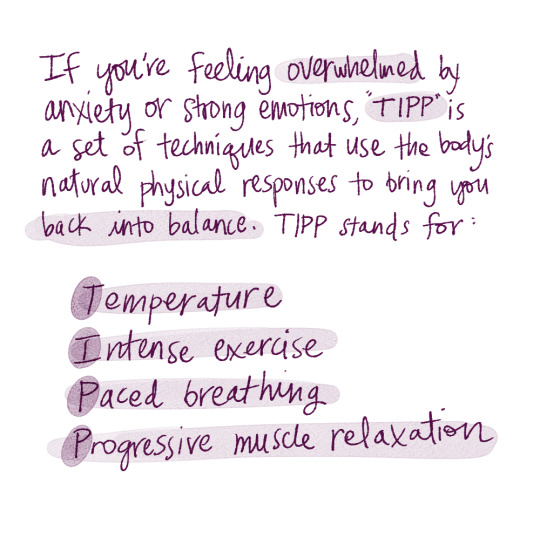
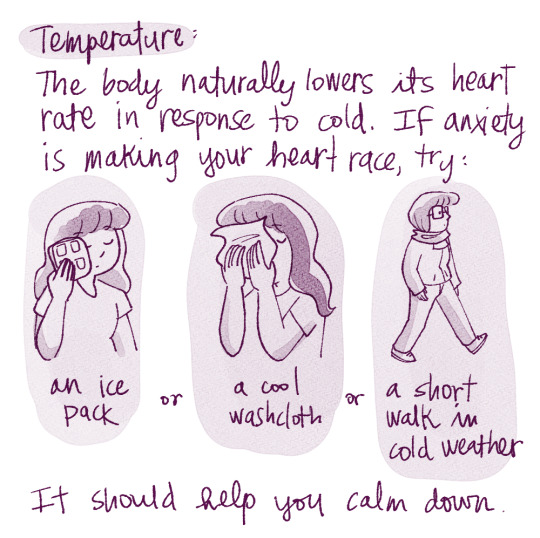

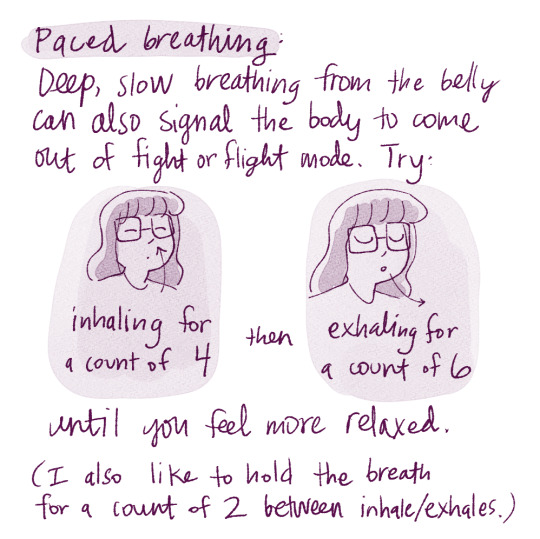
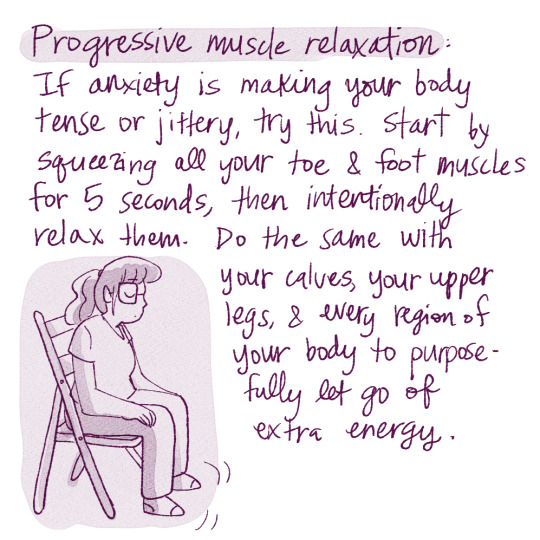
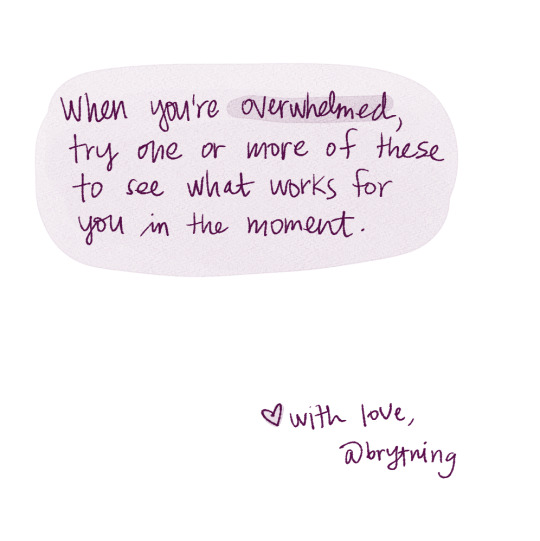
I was talking to my therapist about some anxiety symptoms --- "In my mind, I know I'm going to be perfectly okay, but my body doesn't listen and reacts anyway" --- and she recommended TIPP as strategies to keep in my toolbox of dealing with distress in the moment. I really appreciate having more than one option to try in moments of overwhelm!
Transcription below:
If you're feeling overwhelmed by anxiety or other strong emotions, TIPP is a set of techniques that use the body's natural physical responses to bring you back into balance.
TIPP stands for
temperature
intense exercise
paced breathing
progressive muscle relaxation
Temperature:
The body naturally lowers its heart rate in response to cold. If anxiety is making your heart race, try an ice pack, a cool washcloth, or a walk outside in cool weather, and it should help you calm down.
Intense exercise:
Anxiety is typically a symptom of your body going into fight/flight mode. If your body is coursing with nervous energy, burn it off with 10 minutes of jumping jacks, dancing, climbing stairs, or another cardio activity to complete the stress response cycle.
Paced breathing:
Deep, slow breathing from the belly can also help signal the body to come out of fight/flight mode. Try inhaling for a count of four and exhaling for a count of six until you feel more relaxed. (I like to hold the breath for a count of two between each inhale and exhale.)
Progressive muscle relaxation:
If anxiety makes your body tense up, try this. Start by squeezing the muscles in your toes and feet for five seconds, and then intentionally relax them. Move up to the calves, up your legs, and every region of your body to purposefully let go of extra energy.
When you're feeling overwhelmed, try one or more of these to see what works for you.
#self-care sunday#self-care#anxiety#anxiety relief#managing anxiety#dbt#tipp#mental health#mental health resources#stress
8K notes
·
View notes
Text
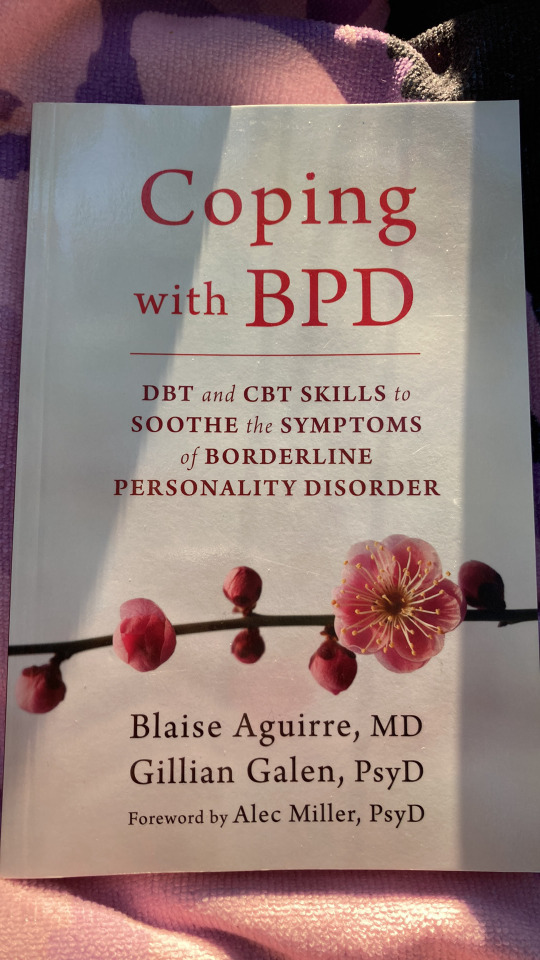
I cannot fucking believe I forgot I own this book (I mean I can but yknow)
I highly recommend it if you can afford the purchase, but I will 10000% end up posting this entire book on my blog overtime. It’s a bit short but gets right to the point. Here’s the contents (apologies for the weird lighting I’m outside)


#treatment mall#mental health positivity#mental health awareness#mental health recovery#mental health support#mental health resources#borderline personality disorder#borderline pd#bpd#bpd traits#living with bpd#living with borderline#actually borderline#actually bpd#bpd support#bpd resources#personality disorders#bpd help#bpd life#being borderline#dbt#dbt therapy#dbt skills
486 notes
·
View notes
Text

#tumblr quotes#mental health reminders#mental health resources#mental health awareness#positive mental attitude#islam and mental health#mental health
32 notes
·
View notes
Text
Here are some calming games and such that I find are really helpful if you want to check them out :)
I will also be adding these to my pinned post so you can come back to them, and if I find new ones I will update the list with them
https://www.jigsawexplorer.com/
https://play2048.co/
https://all2048.com/
https://wordleunlimited.org/
https://merge-fruit.com/fruit-merge
https://www.arkadium.com/games/block-champ/
16 notes
·
View notes
Text
BFRB Resources for Struggles Like Ours
These resources vary from reliable sites and blogs to published journal articles, professional papers, books, and more. If you have any recommendations for me, feel free to Submit something.
A separate post for tips, tricks, and non-affiliate product recommendations will be linked here as soon as I've posted it.
Now then, some of you may be wondering...
What is a BFRB?
Body-focused repetitive behaviors are among the most poorly understood, underdiagnosed, and untreated group of mental health disorders.
According to the TLC Foundation for BFRBs:
"Body-focused repetitive behaviors (BFRBs) include any repetitive self-grooming behavior that involves biting, pulling, picking, or scraping one’s own hair, skin, lips, cheeks, or nails that can lead to physical damage to the body and have been met with multiple attempts to stop or decrease the behavior."
(From the TLC Foundation's webpage, "What is a BFRB?")
The PickingMe Foundation says:
"BFRB's are self-grooming behaviors in which individuals pull, pick, scrape, or bite their own hair, skin, or nails, resulting in damage to the body. Many people are more familiar with its sister disorder, Trichotillomania - Hair Pulling Disorder."
(From the PickingMe Foundation's webpage, "What is Dermatillomania?")
The Recovery Village describes BFRBs as:
"Body-focused repetitive behaviors (BFRBs) are a group of mental health conditions that cause people to bite, pick, pull or scrape their skin, hair or nails compulsively. While some people with BFRBs have awareness and insight into their behaviors, others do them automatically. BFRBs are often linked with disorders like anxiety or substance abuse. Treatment is essential for people with BFRBs, but many often hide evidence of these harmful actions and have trouble asking for help."
(From The Recovery Village's webpage, "Body-Focused Repetitive Behaviors")
According to Angela Hartlin's skin-picking support website:
Body- Focused Repetitive Behaviours (BFRB’s) “is an umbrella term for any chronic behavior that causes a person to consistently cause physical damage to oneself unintentionally through a compulsive act in order to relieve anxiety.” The key difference between BFRB and other compulsive behaviours that cause harm to the body is that BFRBs are characterised by direct body-to-body contact. The website goes on to list other BFRBs such as: hair-pulling disorder (trichotillomania), hair eating disorder (trichophagia), skin biting disorder (dermatophagia), nail biting disorder (onychophagia), and nose picking disorder (rhinotillexomania).
Getting BFRBs officially classified as disorders has been a long, slow process that only hurts those of us who struggle with them daily, as treatments and available resources relating to BFRBs can be very difficult to find. That's the reason why I'm composing this. I'll keep updating this post to the best of my abilities, both for myself and for anyone else it might help.
The good news is that while progress may be slow, there is still progress. Dermatillomania was finally added to the DSM-V-TR under the same OCD-Related Disorders umbrella as Trichotillomania, which has been a big step in the right direction. The more awareness brought to BFRBs, the sooner more can be recognized for what they are so the people suffering from them can receive proper medical and psychiatric help where necessary.
Are BFRBs a type of self-harm?
No.
While the two are not mutually exclusive, the general consensus seems to be that where self-harm is voluntary, BFRBs are grooming behaviors that have gone awry to the point that they are categorized as "OCD-Related Behaviors" in the DSM-V-TR due to their compulsory nature. These behaviors may or may not be driven or worsened by anxiety.
In the case of BFRBs, even though these behaviors cause varying degrees of bodily harm, they're ultimately driven by impulses and urges that cannot easily be controlled. Quite often the triggering event is discovering a physical imperfection in any way for any reason and attempting to "fix" it, despite the behavior being counterintuitive to the goal. The resulting behavior can occur actively or passively, with severe active episodes usually likened to being held hostage in your own body.
There is no desire to harm and very little ability to stop, and then all of it is followed by distressing feelings such as shame, guilt, or embarrassment. We try so hard to "break the habit" that we ultimately beat ourselves up mentally for "failing" yet again. Even though many of us might know we can't control it, it's too easy to blame ourselves for something we feel is somehow our fault.
[Please be advised the purple paragraphs below are personal examples with a few details that may be triggering for some.]
For example, the only way I can come out of bad episodes is when my bodily literally cannot continue. This may look like my back giving out from leaning on the counter in the bathroom, or my legs going completely numb from sitting for too long, or (much more commonly) my fingers or nailbeds hurt too much for me to keep using them, regardless of how much I may or may not have bled.
This is always followed up by what I call the "walk of shame" phase as I clean up every injury, apply Neosporin or other balms/salves, and bandage what I can. I've burst into tears before when I had to use Neosporin like it was lotion in order to cover everything, because I had too many wounds on my arms to be able to safely apply bandages/plasters.
No part of that process, from the trigger response to the cleanup, is something I want to do. If I had a say in it, I'd never pick or bite ever again, and my skin would finally be able to heal.
Self-harm, on the other hand, is a term reserved for bodily harm that is deliberately inflicted on oneself, usually as a way of dealing with difficult emotions, memories, situations, or experiences. Instead of acting on an uncontrollable compulsion, this type of harm stems from a different set of triggers, many of which relate to trauma or other disorders. This makes the behavior more of an unhealthy coping mechanism for people in pain who are desperate for release from those feelings.
Note: If you are unsure if your behaviors are a result of a BFRB or self-harm, Crisis Text Line is a good resource:
"Self-harm is serious. And, while the intention behind self-harm usually is not death, it can still be dangerous—both physically and emotionally. Talking to someone who can help you find alternatives is incredibly important. Of course, you can start by texting us. Also, consider telling someone you know who can help you connect with a professional."
General BFRB Resources:
Sites:
The TLC Foundation - "The TLC Foundation for Body-Focused Repetitive Behaviors helps end isolation and shame for people experiencing hair pulling, skin picking, nail biting, cheek biting, and associated behaviors." They feature a robust website full of information on all BFRBs, including "Medications for BFRBs" and "Evidence-based Therapeutic Treatment for BFRBs."
The Recovery Village - "The Recovery Village aims to improve the quality of life for people struggling with substance use or mental health disorder with fact-based content about the nature of behavioral health conditions, treatment options and their related outcomes. We publish material that is researched, cited, edited and reviewed by licensed medical professionals." (BFRB-specific information can be found here.)
SkinPick.Com - While this site is centered around skin picking/excoriation disorder/dermatillomania, they have excellent resources for other BFRBs as well, including their Glossary page, "Complete List of BFRBs," and the blog section for "Related Disorders." I have also listed their site in the Dermatillomania section below.
Articles:
Online Journal: International Journal of Environmental Research and Public Health, Special Issue: "Body-Focused Repetitive Behaviours (BFRBs). Risk Factors, Prevention, Treatment"
The Recovery Village’s article, "7 Myths About Body-Focused Repetitive Behaviors"
The Recovery Village’s article, "8 Little Known Facts About Body-Focused Repetitive Behaviors"
Outreach:
"Health Education & Community Programs" (the TLC Foundation)
Communities & Support:
PickingMe Foundation's Online Support Group.
TLC Foundation's Support Group Directory for peer-led support groups.
SkinPick's online Forum.
Self-Help:
Nathan Peterson's ComB Model for BFRB Treatment, Part 1 and Part 2 on YouTube. Peterson is a licensed OCD specialist who helps people with OCD, anxiety, and BFRBs in person, through his OCD & Anxiety YouTube channel, and through his site, OCD-Anxiety.Com. (His BFRB specific course can be found on his site here.)
SkinPick's free self-guided program to stop skin-picking.
PickingMe Foundation's Derma Resource Packets "...are our campaign to spread Dermatillomania awareness to skin care providers (Dermatologists, Estheticians, Nail Salons, Clinicians), mental health professionals, and anyone who wants more info! We provide them with tools and the opportunity to point Skin Picking Disorder sufferers in the right direction."
PickingMe Foundation's Management Tips page, a "growing list of tips and management strategies!"
Mobile Apps:
SkinPick App – "A free tool to monitor your skin picking behaviors."
Specific BFRB Resources:
Onychophagia:
Not every instance of nail-biting is considered onychophagia. Most nail-biting behavior dissipates over time. It’s when it doesn’t that the behavior requires a closer look. Chronic nail-biting is categorized as an obsessive-compulsive related disorder in the Diagnostic and Statistical Manual of Mental Disorders (DSM-5-TR).
SkinPick's blog post, "Onychophagia: More Than a Nervous Habit"
"Art of Prevention: The importance of tackling the nail biting habit," authored by Mohsen Baghchechi BS, Janice L. Pelletier MD, FAAP, Sharon E. Jacob MD, FAAD, FAAP. Published in the International Journal of Women's Dermatology, Volume 7, Issue 3, June 2021, Pages 309-313.
"Update on Diagnosis and Management of Onychophagia and Onychotillomania," authored by Debra K. Lee and Shari R. Lipner. Published in the International Journal of Environmental Research and Public Health, 2022, 19, no. 6: 3392.
Dermatophagia:
Formerly referred to as "wolf-biting," dermatophagia has yet to be recognized as a diagnosable disorder.
SkinPick's blog post, "Do you eat your own skin after picking? There's a name for that."
SkinPick's blog post, "Dermatophagia - What is it?"
Dermatillomania:
Dermatillomania means “Skin Pulling Madness,” and has only been diagnosable since 2013. It is currently classified as an “Obsessive-Compulsive and related disorder” in the Diagnostic and Statistical Manual of Mental Disorders, Fifth Edition (DSM-5), where it is listed as Excoriation Disorder. However, it is known by many names, such as: Skin Picking Disorder, Compulsive Skin Picking, Acne Excoriée, Pathological Excoriation, Neurotic Excoriation, Pathological Skin Picking, and Psychogenic Excoriation. The many names for this disorder cause interference with its understanding and awareness.
Dermatillomania is often confused with other conditions. Common misdiagnoses result because the picking behavior is a result of a medical condition, confused with OCD, Body Dysmorphic Disorder (BDD) and in some cases, Non-suicidal Self-Injury (NSSI).
PickingMe Foundation - "Picking Me Foundation NFP is the only donor-supported non-profit dedicated to advocating for Dermatillomania (Skin Picking Disorder) sufferers, supporters, and educational communities alike, encouraging individuals to choose themselves over the mental illness that chose them by #PickingMe over Skin-Picking."
Angela Hartlin's Skin Picking Support website. Hartlin is the author of, "FOREVER MARKED: A Dermatillomania Diary" and the creator of the documentary, "Scars of Shame," which you can watch for free here with the password, "Scars1" (Thanks, Angela!)
SkinPick.Com - "SkinPick is the #1 platform to treat excoriation disorder (dermatillomania). Get one-on-one support from a therapist specializing in treating compulsive skin-picking through evidence-based techniques."
SkinPick's "Do I Have Dermatillomania?" Test
SkinPick's blog post. "Skin Picking and Body-Focussed Repetitive Behaviours (BFRB)"
Stuff That Works’ page, “Excoriation (Skin-Picking) Disorder”
Trichotillomania:
Probably the most famous BFRB, Trich has the most resources available thanks to being the first diagnosable BFRB. The resources below are more general as a result:
TrichStop - "TrichStop is the world’s leading platform for Trichotillomania treatment. Get one-on-one support from a therapist specializing in treating compulsive hair pulling through evidence-based techniques." From the same support team behind SkinPick.Com.
TrichStop's "Do I Have Trichotillomania?" Test
TrichStop's blog post, "Trich and Comorbid Disorders: What We Are Learning"
The TLC Foundation's Trichotillomania page.
"Trichotillomania," authored by Aubree D. Pereyra; Abdolreza Saadabadi. Published in StatPearls [Internet]. Treasure Island (FL): StatPearls Publishing; 2023 Jan-. (Ongoing)
More to come.
There are more BFRBs than this out there, but I don't have the resources gathered for them yet. Hopefully the General resources help! I'll update this as I have time. In the meantime, I wish you all luck on your BFRB journeys.
-> Anxious? Try This:

#bfrb#bfrb awareness#resources#bfrb resources#dermatillomania#dermatophagia#onychophagia#trichotillomania#mental heath support#mental health#signal boost#awareness#mental health resources#compulsion#obsessive compulsive disorder#anxiety#skin biting#skin picking#nail biting#self help#bfrb research#psychology#psychology research#abnormal psychology#bfrb studies
35 notes
·
View notes
Text






Jared took on a more serious tone tonight while live-tweeting, but it's very much appreciated!
And if you ever feel you need some additional help, or just need to talk with someone, The Green Cooler provided some helpful resources:

Take care of yourself first because you are important, you are needed, and I'll repeat, you are loved!
#jared padalecki#philemon chambers#the green cooler#mental health resources#walker#walker support#walker 3.03#jared tweets#philemon tweets
107 notes
·
View notes
Note
Hi. I need advice. My bf has depression and while it hasn't been terrible while we have been dating , recently he seems more distant and has mentioned he feels stuck in life, he's constantly unsure now which is very not him and keeps quiet and says "I dont know" alot. We and his friends think his depression is slowly coming back, because obviously it doesn't go away. I dont know how to help, because I do feel like its putting a strain on our relationship, we're currently doing long distance due to work so we arnt able to have our similar routine. His communication skills are not the best, we have small arguments frequently mainly due to his lack of interest on the conversation or his small outbursts. Which at the time I didnt put two and two together but now it kinda make sense. I feel like he has become distant and dont seem engaged at all when we have little time to talk. While I feel for him, im getting frustrated because our fight seem to be the same pattern, of him not being able to communicate properly. I've expressed this before as this is all we have at the moment and he seems to understand but doesn't seem to make much effort of trying. I do think the distance has affected this and he doesn't seem to realize, he a very actions person and he has expressed that he feels useless bc he can't do much for me while I'm away. Were so well together in person but lately we seem like a completely different couple . I'm not sure what to do, I think I want to give him some space , which makes me a bit sad bc we hardly have much time to chat. I ask him if he needs alone time ,etc but he can't seem to answer me with a direct answer. During our relationship his depression hasn't been bad , its been maybe mild but nothing to this effect, it's never caused a shift in our relationship but this time it feels different. So im.not sure how to go about this. Any advice would help, I do love him and want our relationship to grow but the past couple of months it seems more draining and mentally exhausting.
I know this is a very, very late response, but when things get like this for depressed people, it can be a red flag for potential suicidal ideation.
That said, being depressed can also cause a lot of brain fog, which makes people indecisive, dissociative, unable to think to the future, etc. This happens because of how exhausting and draining depression can be, especially in a world that demands you always be doing something, anything, at every moment. People with depression are extremely susceptible to burnout.
He could need a change in medication/treatment, or a change in environment, or a change in his support systems. Or sometimes, it's just a temporary rut in life. Doing more positive and/or relaxing things can also help, such as colouring in books, going to a movie, starting a new series, visiting an animal sanctuary, going on a hike, going to an amusement park, etc. Things that don't require a lot of effort and can be simply enjoyed, depending on social tolerances (ex: a museum could be a bad idea because there's too many people and it overwhelms).
There's also the fact that the strain on your relationship could be the cause of the depression and not the other way around. Which is to say, because you guys aren't in your usual routines and aren't able to experience each other often, his depression is returning. A lot of depressed people rely on routine and partner support to supplement their treatments. Breaking routine in particular can leave someone feeling lost, hopeless, confused, stuck, and so on. Plenty of people need routine to feel purpose and direction in their lives.
Depression can cause more arguing because it can deplete one's ability to tolerate others. Again, this is because of how draining depression is, which leaves someone with significantly less spoons and overwhelmed easily. Shutting down is a natural defense mechanism and presents itself as aloofness, sudden bouts of anger, disinterest in anything, inability to conversate, and so on. There can be different ways to treat these individual symptoms which can improve the overall depression.
If he seems to struggle still with communication or explaining what he wants and thinks, have him start keeping a journal or notebook where he writes everything he is feeling, or even draws pictures. Have him jot down any time his mood dips and what happened at the time it did, and maybe he can find triggers for what's going on with him.
But, it is fair to be frustrated. You have your own feelings and likely own problems as well and for the support YOU needed to be taken away is absolutely a frustrating thing. It's a good idea for you to find other support in this trying time to maybe take the pressure off of him.
If you haven't already, I would communicate to him exactly how you're feeling, and that you want to help but you don't know what to do. Ask him what he needs most right now - a distraction? a discussion? a solution? - and follow through. If he can't decide about it, emphasize you're there for when he knows. Additionally, explain to him that there's always gonna be sometimes when you two can't be in person and that he can't fix everything every time, and that you don't expect him to.
Here are some resources for both of you:
Getting Out of a Funk: How to Help Yourself Through Depression
Tips for managing depression in relationships
Babylon: How Depression Can Affect Relationships
Self-care Wellness Toolkit
Worksheet for depression coping skills
How to talk to someone who has depression
How and Why to Practice Self-Care
How can I communicate with someone with depression?
Depression in relationships
How to Tell Someone You're Depressed
Helping Someone with Depression
The Impact Your Mental Health Can Have on Communication
PsychCentral: 10 Self Care Tips for When You Have Depression
Anna Freud: Self Care
What Not to Say or Do to Someone Who Has Depression
Coping with Depression
How to Talk to Your Partner About Your Depression
How Depression Affects My Ability to Communicate
Psychology Today: Why Self Care is Hard for Depressed Individuals
The Royal Australian & New Zealand College of Psychiatrists: Self-care for depression
6 Powerful and Effective Ways to Communicate Better in Relationships
5 Signs that Depression is Eroding Your Relationship
How to Talk about Depression with Family and Friends
Tips On Communicating With Those Who Have Depression
6 Dos and Don'ts for Supporting Someone Who Has Depression
22 Ways to Cope with Your Depression
NIH: Caring For Your Mental Health
Depression Self Help Guide
Mindfulness and Relaxation Techniques to Help with Depression Symptoms
Healthy Coping Skills for Depression, Anxiety, and Anger
Clear Minds Center: Tips for Communicating with Someone Who is Depressed
How Depression Effects Relationships and What You Can Do
What to Know About Dating Someone With Depression
Relationships and Communication
How to use mindfulness for depression
Depression in Relationships: When to Say Goodbye
-Mod BP
#did I say some? I meant a lot#depression#communication#relationships#relationship advice#mental health resources#mental health#depression resources#suicide m tw -#asks#anonymous#self care#self care resources
12 notes
·
View notes